A Study on the Characterization of Asphalt Plant Reclaimed Powder Using Fourier Transform Infrared Spectroscopy
Abstract
1. Introduction
2. Materials and Methods
2.1. Materials
2.2. Methods
2.2.1. Scanning Electron Microscopy (SEM)
2.2.2. X-Ray Fluorescence Spectroscopy (XRF) Test
2.2.3. X-Ray Diffraction (XRD) Test
2.2.4. Fourier Transform Infrared Spectroscopy (FTIR) Test
2.2.5. Methylene Blue (MB) Test
3. Results and Discussion
3.1. SEM Observation Results (Filler Micromorphology)
3.2. XRF Test Results (Filler Acidity/Alkalinity)
3.3. XRD Test Results (Filler Crystal Structure)
3.4. Methylene Blue Test Results (Filler Cleanliness)
3.5. FTIR Spectroscopy Analysis
3.5.1. Functional Group Analysis and Characteristic Peak Index Calculation of Fillers
- IC: Carbonate functional group index (1310 cm−1~1550 cm−1);
- IS: Siloxane functional group index (930 cm−1~1070 cm−1);
- IS/C: Siloxane-to-carbonate ratio index;
- IC/S: Carbonate-to-siloxane ratio index;
- AXXX: Integrated peak area at XXX cm−1 wavenumber.
3.5.2. Optimization of Evaluation Indicators for Acidity/Alkalinity (Based on XRF and Pull-Off Tests)
3.5.3. Optimization of Cleanliness Evaluation Indicators (Based on Methylene Blue Test)
4. Conclusions
- The reclaimed powder mainly consists of tiny, crushed stone particles and dust, with significant variations in crystal structure and chemical composition, including calcium carbonate, silicon oxide, iron oxide, aluminum oxide, etc. Some samples also contain clay, which is the primary factor affecting their properties. The presence of clay increases the acidity of the filler while reducing its cleanliness. Since the main component of clay is aluminosilicate, the silicon–oxygen–silicon (Si-O-Si) characteristic peak at 1000 cm−1 can be used to quantitatively evaluate clay content.
- In the infrared spectrum, the Si-O-Si absorption peak at 1000 cm−1 and the antisymmetric stretching peak of carbonate at 1400 cm−1 show excellent correlation with the calcium carbonate and silicon oxide content in reclaimed powder. These peaks can be used to predict the filler’s calcium carbonate content, clay content, acidity/alkalinity, and cleanliness. Higher calcium carbonate and lower silicon oxide content indicate less clay, stronger alkalinity, and better cleanliness, making the material more suitable for reuse.
- Based on the Si-O-Si peak at 1000 cm−1 and the carbonate antisymmetric stretching peak at 1400 cm−1, four functional group indices (IC, IS, IS/C, IC/S) were calculated. Their predictive performance for acidity/alkalinity and cleanliness was compared using XRF, methylene blue tests, and pull-off tests, ultimately selecting the IS index due to its strong correlation. The IS index exhibited correlations of R2 = 0.89 with XRF, R2 = 0.80 with methylene blue values, and R2 = 0.96 with pull-off strength, confirming its effectiveness in predicting both acidity/alkalinity and cleanliness.
- Methylene blue tests also revealed that, in the absence of clay, dust and organic residues are the main factors influencing the MBV. However, even trace amounts of clay cause a sharp increase in the MBV, showing a completely different trend compared to clay-free samples. Therefore, during transportation and storage, reclaimed powder should be prevented from contact with clay.
Author Contributions
Funding
Institutional Review Board Statement
Informed Consent Statement
Data Availability Statement
Conflicts of Interest
References
- Chaiyaput, S.; Sertsoongnern, P.; Ayawanna, J. Utilization of waste dust from asphalt concrete manufacturing as a sustainable subbase course material in pavement structures. Sustainability 2022, 14, 9804. [Google Scholar] [CrossRef]
- Abelson, J. Powder Reclamation Methods. In Modern Cold Spray: Materials, Process, and Applications; Springer: Cham, Switzerland, 2015; pp. 317–340. [Google Scholar]
- Sun, Y.; Huang, W.; Xu, G.; Gan, L.; Shen, Z.; Luo, S.; Zhang, H.; Feng, Y.; Xiong, H.; Shu, Y. Experimental investigation on the performance of hydraulic asphalt concrete with varying epoxy system content. Constr. Build. Mater. 2025, 484, 141755. [Google Scholar] [CrossRef]
- Kockelman, K.M.; Siethoff, B.; Walton, M.; Mahmassani, H. Research on Relationships Between Transportation Infrastructure & Increase in Vehicle Miles Traveled: The Effects of Highway Capacity Expansion on Land Development; Final Technical Report for the US Environmental Protection Agency; Center for Transportation Research, University of Texas: Austin, TX, USA, 2002. [Google Scholar]
- Ayawanna, J.; Suksawat, T.; Sertsoongnern, P.; Chaiyaput, S. The use of asphalt waste dust for stabilization of sustainable pavement recycling. Constr. Build. Mater. 2024, 446, 137936. [Google Scholar] [CrossRef]
- Muniandy, R.; Aburkaba, E.E. Effects of filler type and particle size on permanent deformation of Stone Mastic Asphalt (SMA) mixtures. Chem. Eng. 2012, 49, 9902–9909. [Google Scholar]
- Chen, C. A Mineralogical Approach to Use the Non-Qualified Fine Aggregates in Asphalt Concrete Pavement; Université Paris-Est: Créteil, France, 2016. [Google Scholar]
- Wilanowicz, J.; Grabowski, W.; Andrzejczak, M.; Chromiec, A. Assessment of the suitability of baghouse dusts from a dust extractor as fillers for hot-mix asphalt. Procedia Eng. 2013, 57, 1269–1277. [Google Scholar] [CrossRef]
- Mukhtar, N.; Hasan, M.R.M.; Shariff, K.A.; Bergh, W.V.D. Relationship between the physicochemical and electrostatic charge characteristics of filler materials on the morphological and adhesive Pull-Off tensile strength of asphalt mastics. Constr. Build. Mater. 2022, 346, 128343. [Google Scholar] [CrossRef]
- Fowkes, F.M. Role of acid-base interfacial bonding in adhesion. J. Adhes. Sci. Technol. 1987, 1, 7–27. [Google Scholar] [CrossRef]
- Xuan, W. Study on the High Temperature Performance of Composite Modified Hard Asphalt Mixture; Nanjing Forestry University: Nanjing, China, 2023. [Google Scholar]
- Gajewski, M.D.; Horodecka, R.; Bańkowski, W.; Mirski, K.; Grzegórska, A.; Kłopociński, M. Effects of Impurities and Ageing on the Functional and Rheological Properties of Asphalts with Additives from Recovered and Pyrolysis-Processed Plastics. Materials 2024, 17, 3451. [Google Scholar] [CrossRef]
- Biro, S.; Gandhi, T.; Amirkhanian, S. Determination of zero shear viscosity of warm asphalt binders. Constr. Build. Mater. 2009, 23, 2080–2086. [Google Scholar] [CrossRef]
- Topçu, I.B.; Demir, A. Relationship between methylene blue values of concrete aggregate fines and some concrete properties. Can. J. Civ. Eng. 2008, 35, 379–383. [Google Scholar] [CrossRef]
- Hou, X.; He, Y.; Jones, B.T. Recent advances in portable X-ray fluorescence spectrometry. Appl. Spectrosc. Rev. 2004, 39, 1–25. [Google Scholar] [CrossRef]
- Moreno-Maroto, J.M.; Alonso-Azcárate, J.; O’Kelly, B.C. Review and critical examination of fine-grained soil classification systems based on plasticity. Appl. Clay Sci. 2021, 200, 105955. [Google Scholar] [CrossRef]
- Singh, S.K.; Kathait, N.; Kirthika, S.K. Clay Content Assessment in Fine Aggregates Using Phenol Adsorption Method. J. Mater. Civ. Eng. 2022, 34, 04022044. [Google Scholar] [CrossRef]
- Luo, S.; Tian, J.; Liu, Z.; Lu, Q.; Zhong, K.; Yang, X. Rapid determination of styrene-butadiene-styrene (SBS) content in modified asphalt based on Fourier transform infrared (FTIR) spectrometer and linear regression analysis. Measurement 2020, 151, 107204. [Google Scholar] [CrossRef]
- Kępniak, M.; Woyciechowski, P.; Franus, W. Chemical and physical properties of limestone powder as a potential microfiller of polymer composites. Arch. Civ. Eng. 2017, 63, 67–78. [Google Scholar] [CrossRef]
- Zhou, S.; Long, K.; Zhang, Z.; Li, S.; Ai, C.; Yan, C. Development of sustainable Lignin-Based coatings for layered double Hydroxides: Enhancing synergistic Anti-Aging properties in bitumen. Fuel 2025, 380, 133166. [Google Scholar] [CrossRef]
- JTG 3432-2024; Ministry of Transport of the People’s Republic of China. Test Methods of Aggregate for Highway Engineering. China Communications Press: Beijing, China, 2024.
- Bergna, H.E. Colloid chemistry of silica: An overview. Adv. Chem. 1994, 234, 1–47. [Google Scholar]
- Wang, L.; Zhang, L.; Liu, Y. Molecular Dynamics Study on the Effect of Mineral Composition on the Interface Interaction between Rubberized Asphalt and Aggregate. J. Mater. Civ. Eng. 2022, 34, 04022032. [Google Scholar] [CrossRef]
- Yin, Y.; Chen, H.; Kuang, D.; Song, L.; Wang, L. Effect of chemical composition of aggregate on interfacial adhesion property between aggregate and asphalt. Constr. Build. Mater. 2017, 146, 146231–146237. [Google Scholar] [CrossRef]
- Socrates, G. Infrared and Raman Characteristic Group Frequencies: Tables and Charts; John Wiley & Sons: Hoboken, NJ, USA, 2004. [Google Scholar]
- Buzgar, N.; Apopei, A.I. The Raman study of certain carbonates. Geologie 2009, LV, 97–112. [Google Scholar]
- Biswas, B.; Allen, H.C. Solution and Surface Solvation of Nitrate Anions with Iron (III) and Aluminum (III) in Aqueous Environments: A Raman and Vibrational Sum Frequency Generation Study. J. Phys. Chem. A 2024, 128, 8938–8953. [Google Scholar] [CrossRef]
- Ngezahayo, E.; Torbaghan, M.E.; Metje, N.; Burrow, M.; Ghataora, G.S.; Desalegn, Y. Investigating the Effectiveness of Fourier Transform Infrared Spectroscopy (FTIR) as an Antifraud Approach for Modified Epoxy Asphalt Mixes in Developing Countries. Sustainability 2023, 15, 16332. [Google Scholar] [CrossRef]
- Weigel, S.; Stephan, D. The prediction of bitumen properties based on FTIR and multivariate analysis methods. Fuel 2017, 208, 655–661. [Google Scholar] [CrossRef]
- Zhang, J.; Apeagyei, A.K.; Airey, G.D.; Grenfell, J.R. Influence of aggregate mineralogical composition on water resistance of aggregate–bitumen adhesion. Int. J. Adhes. Adhes. 2015, 62, 45–54. [Google Scholar] [CrossRef]
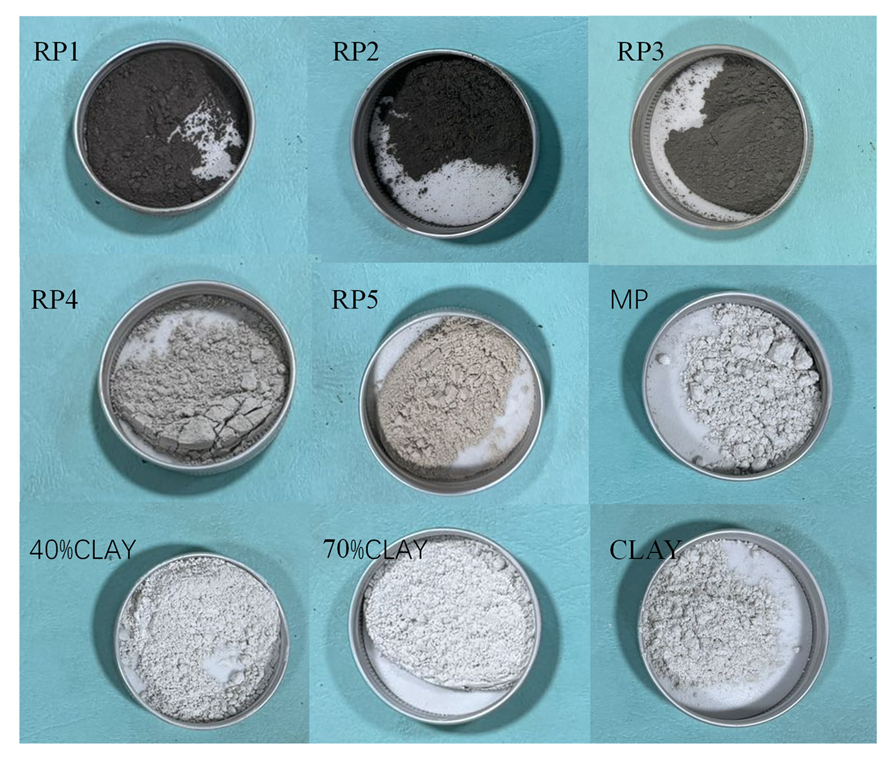
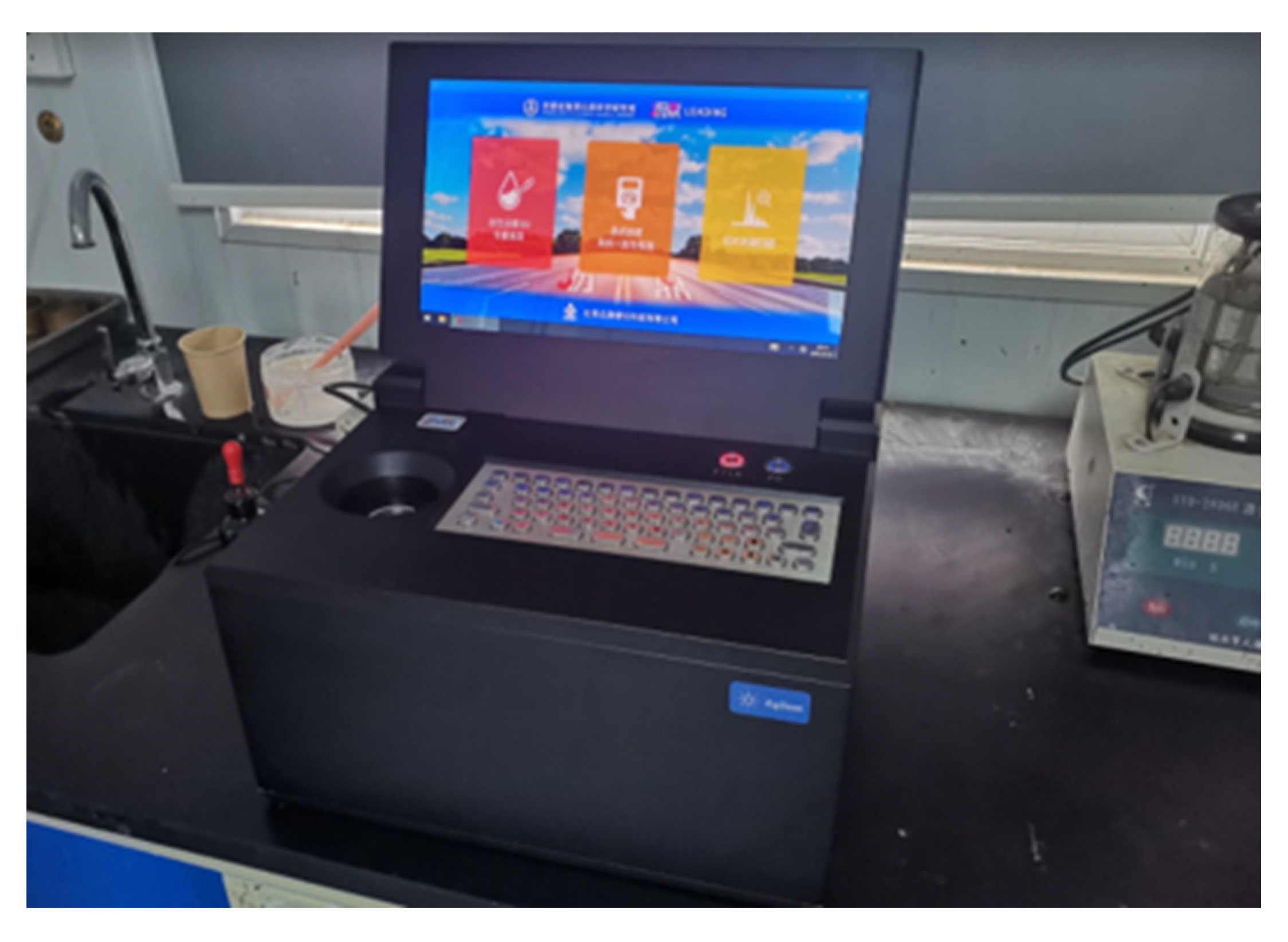
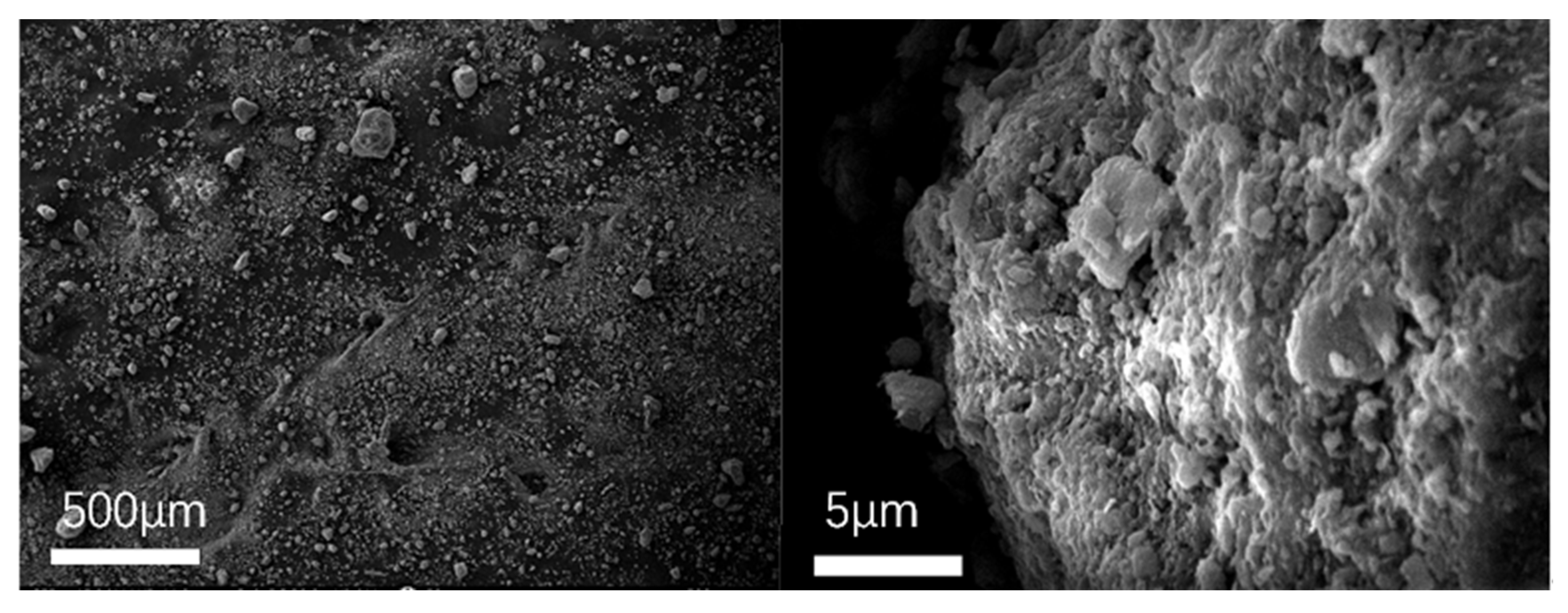
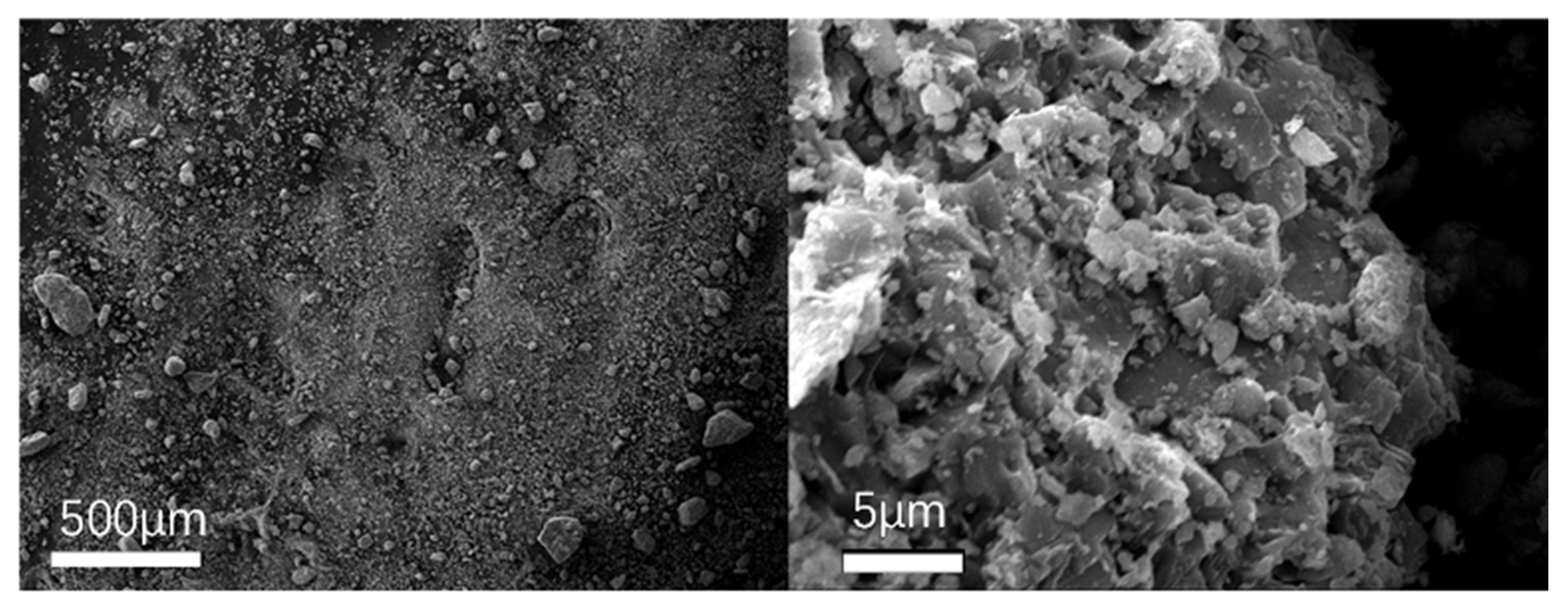
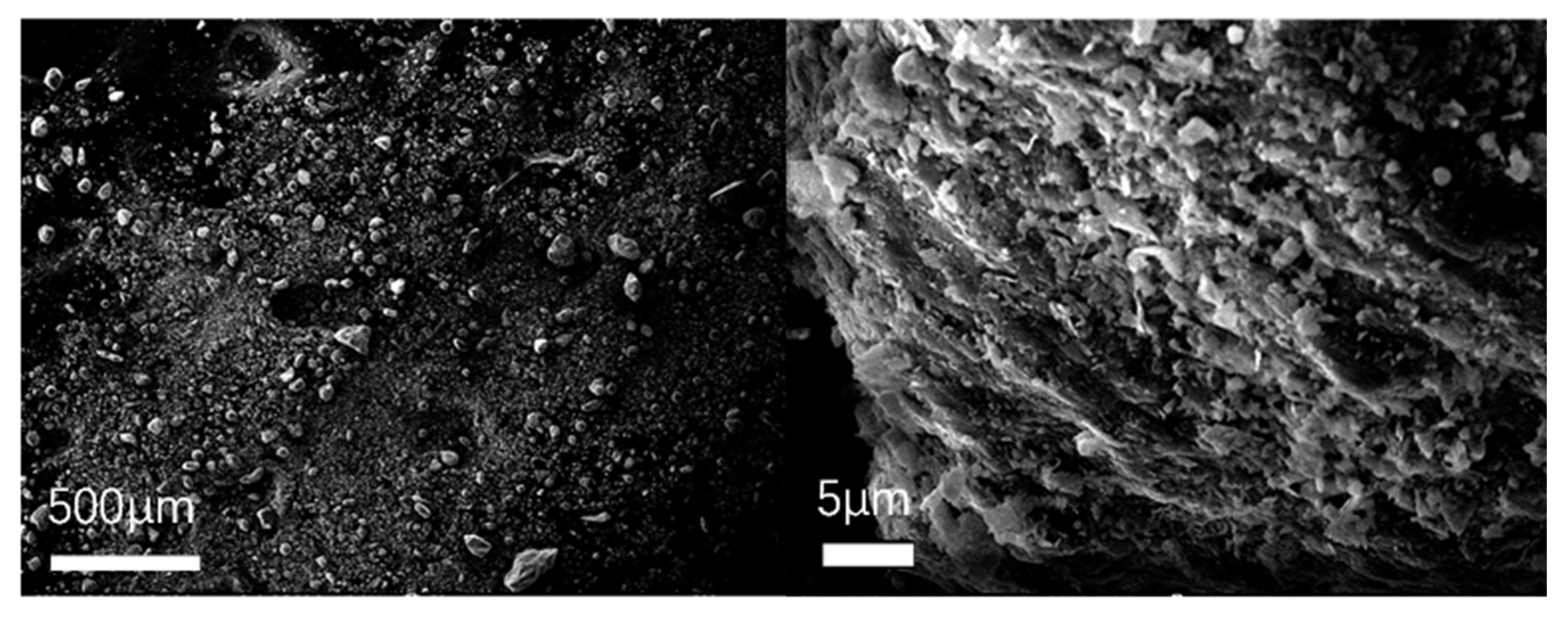
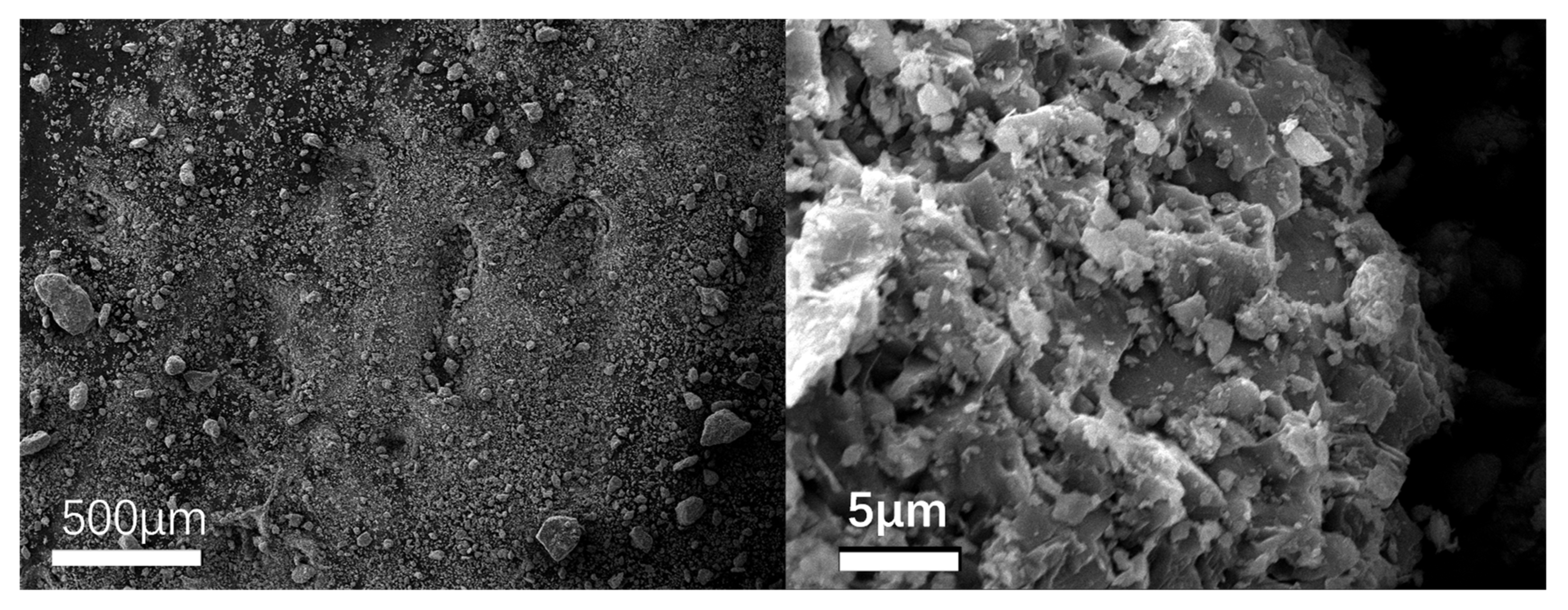
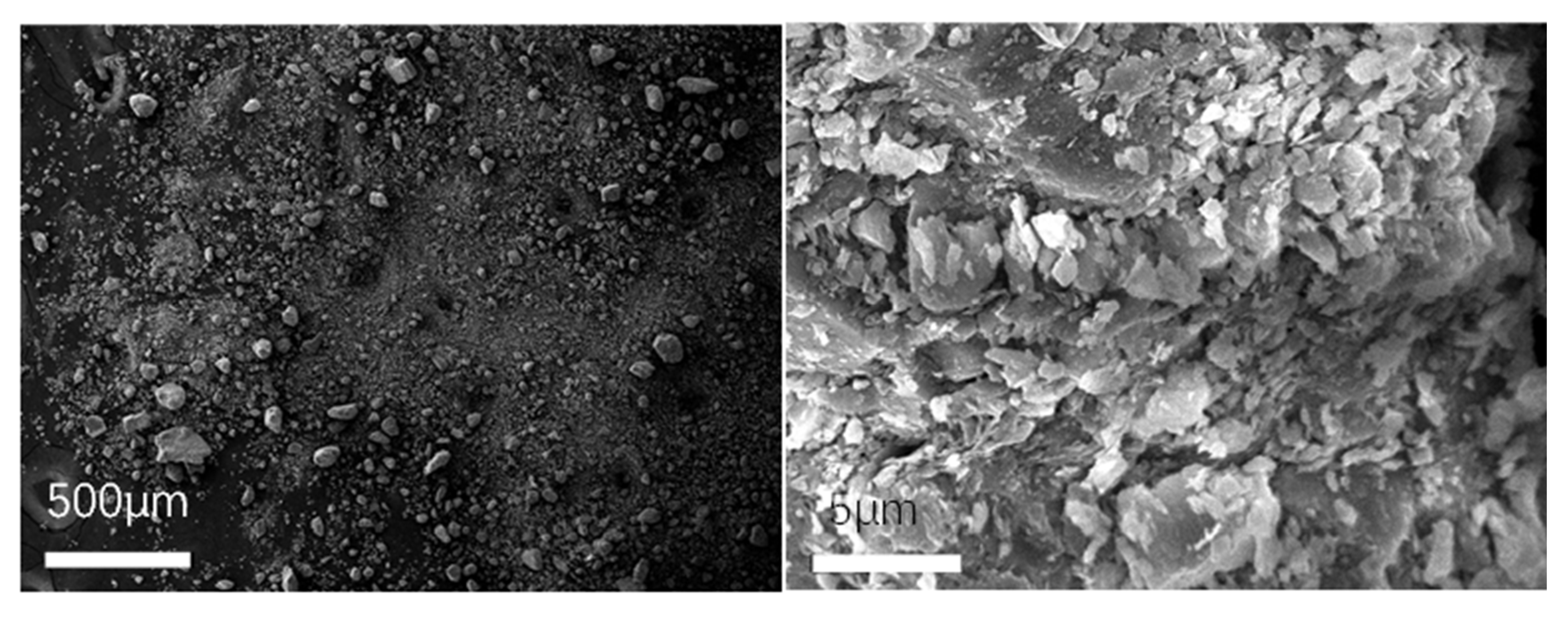
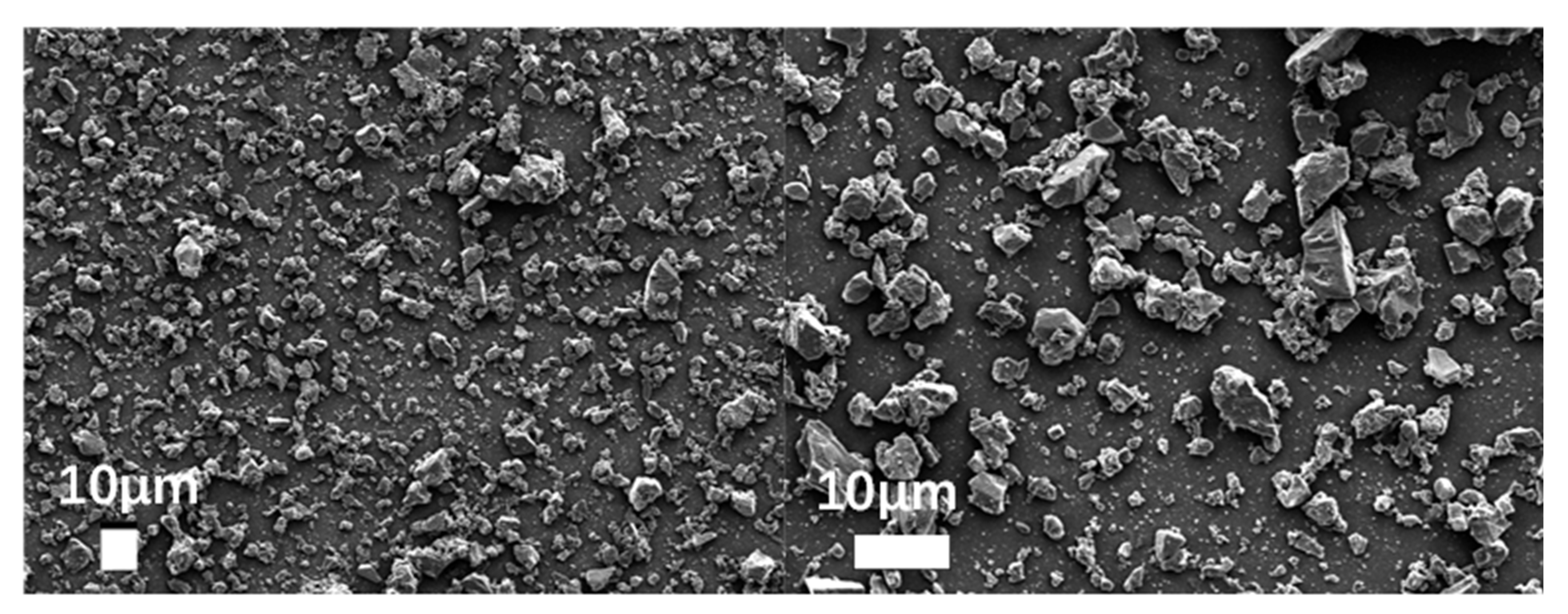
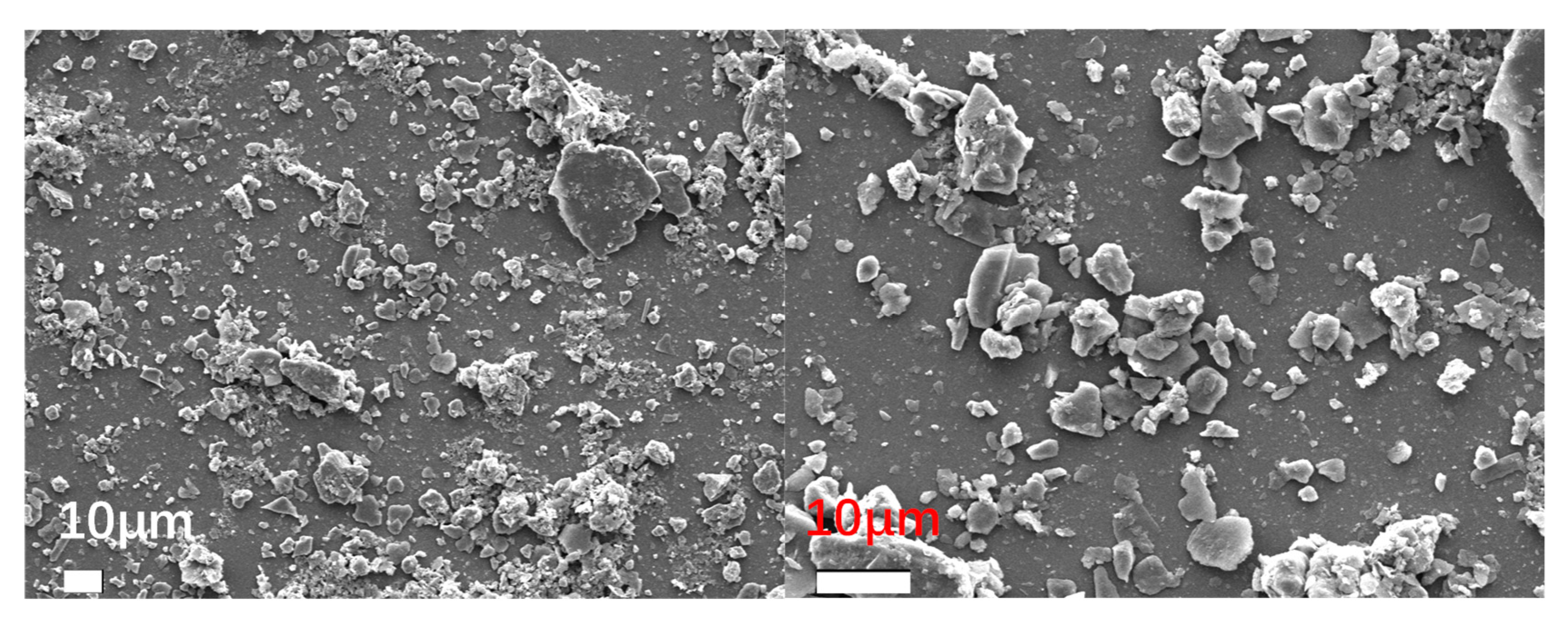
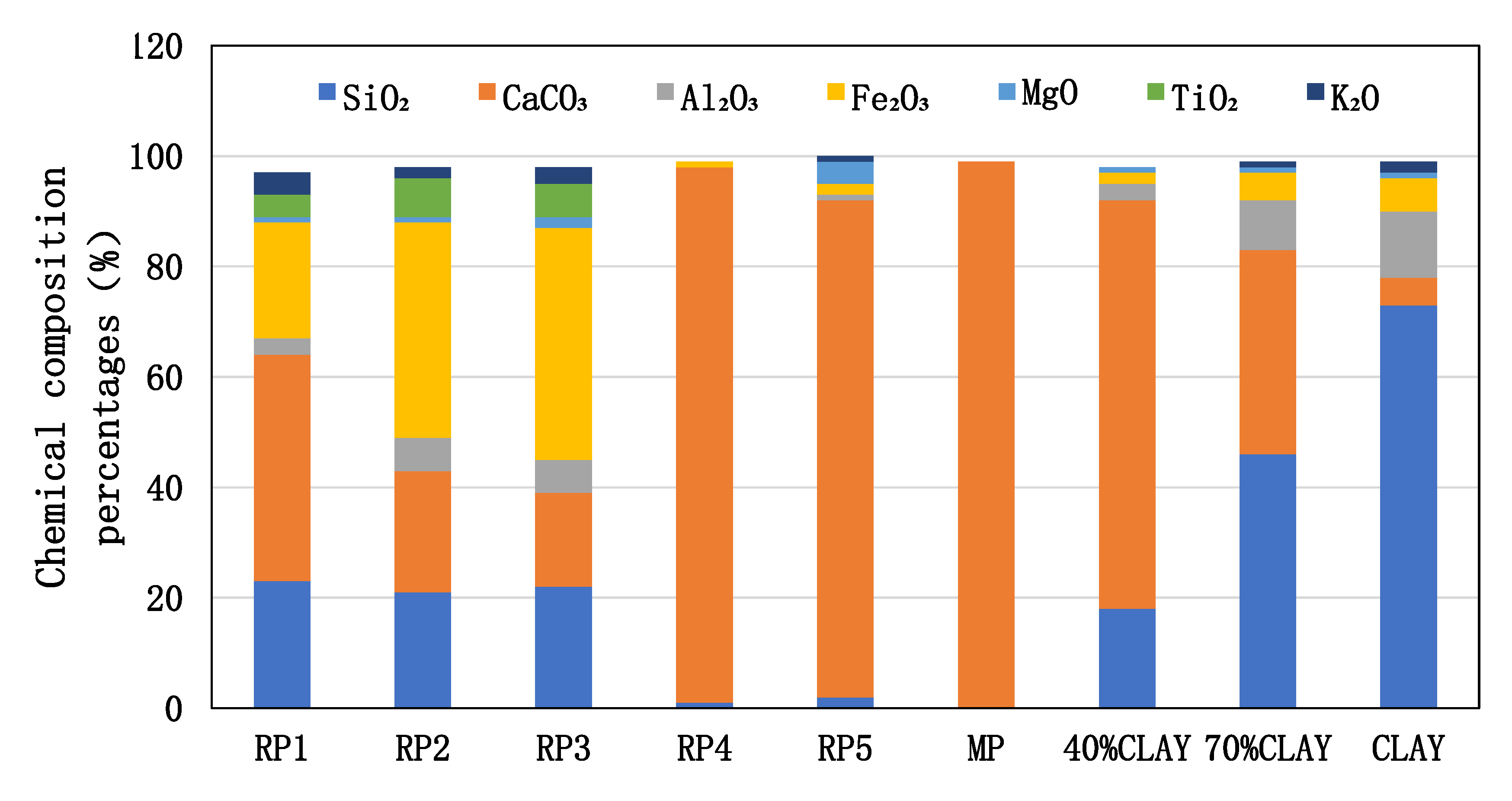
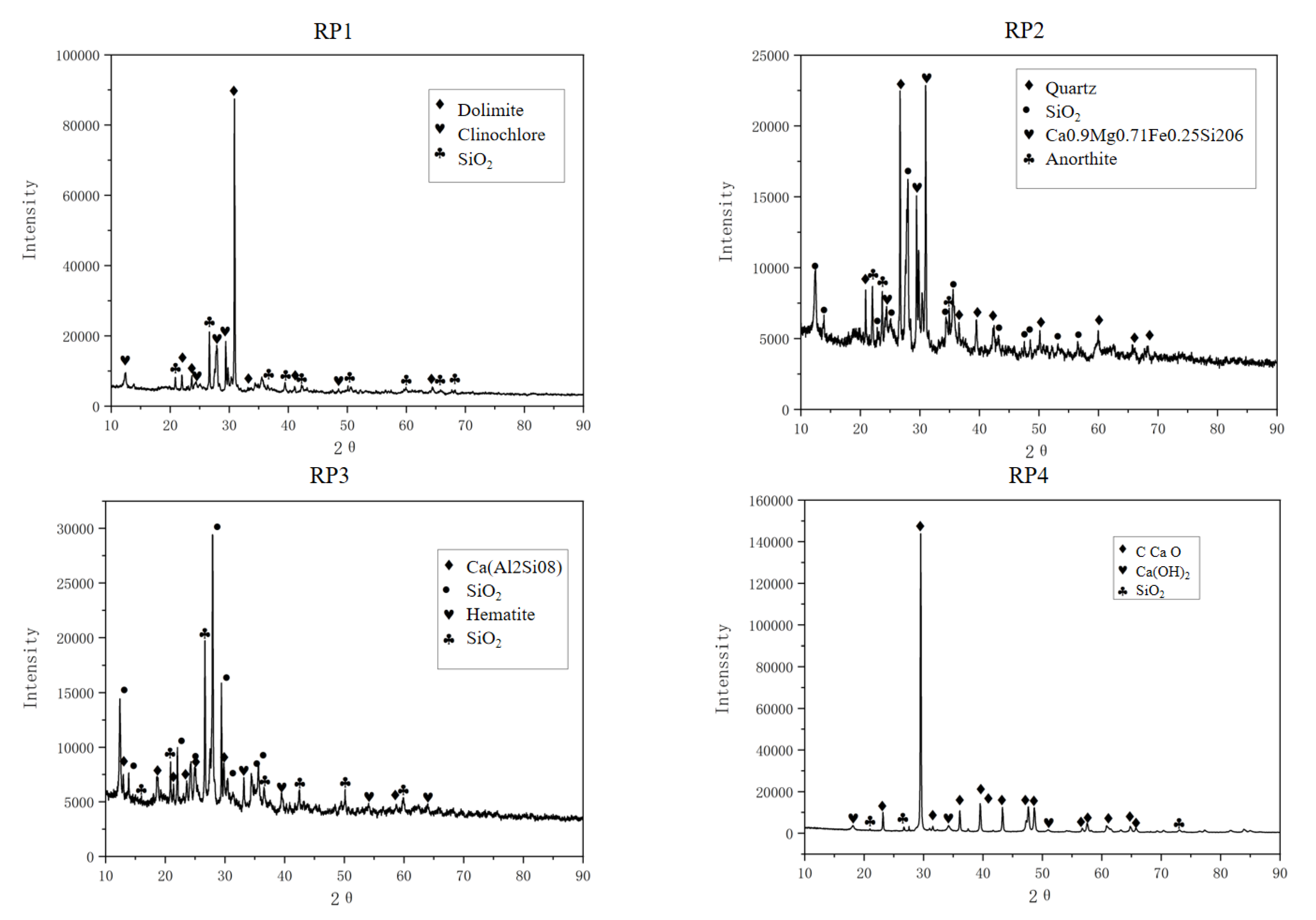
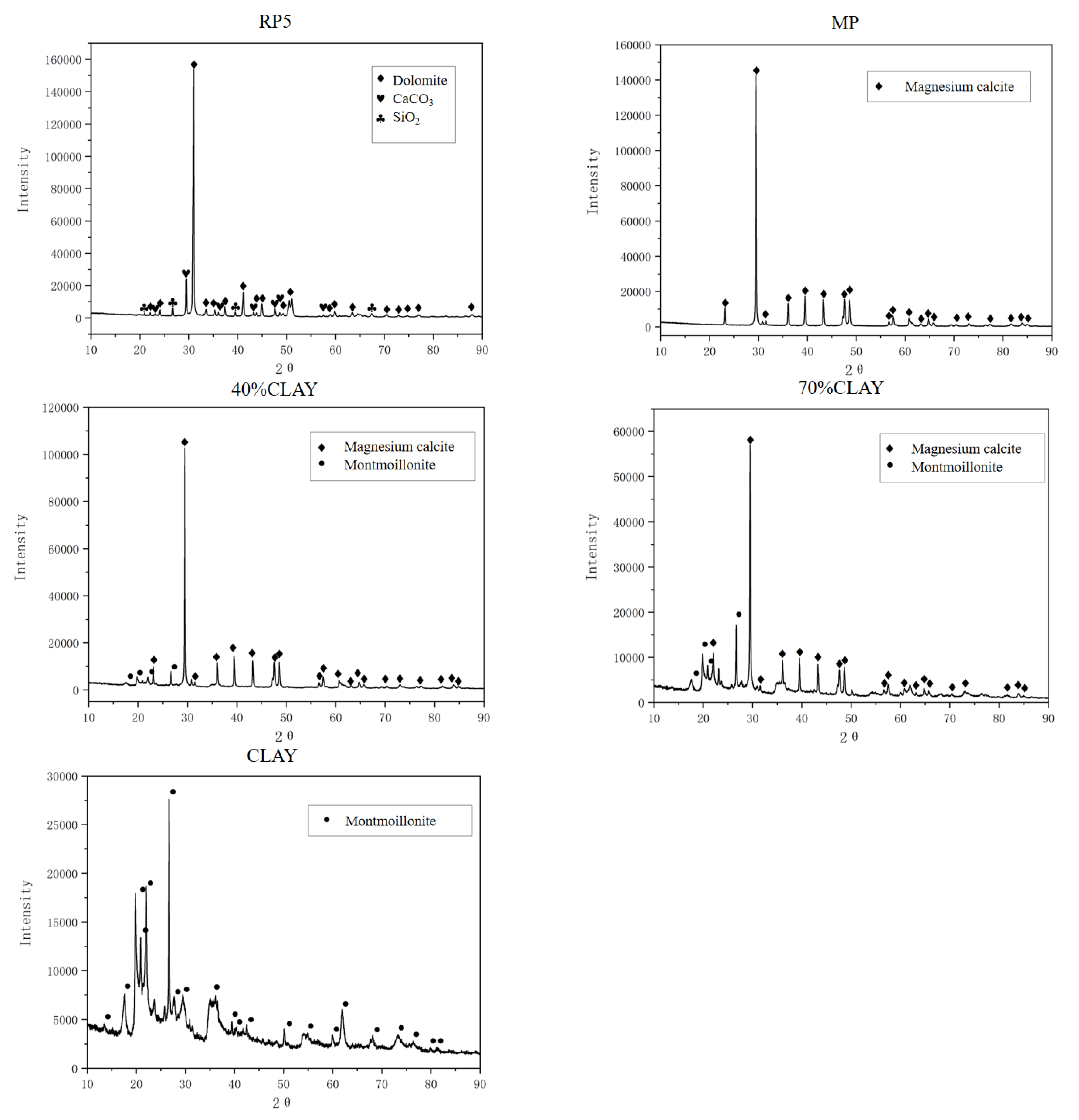
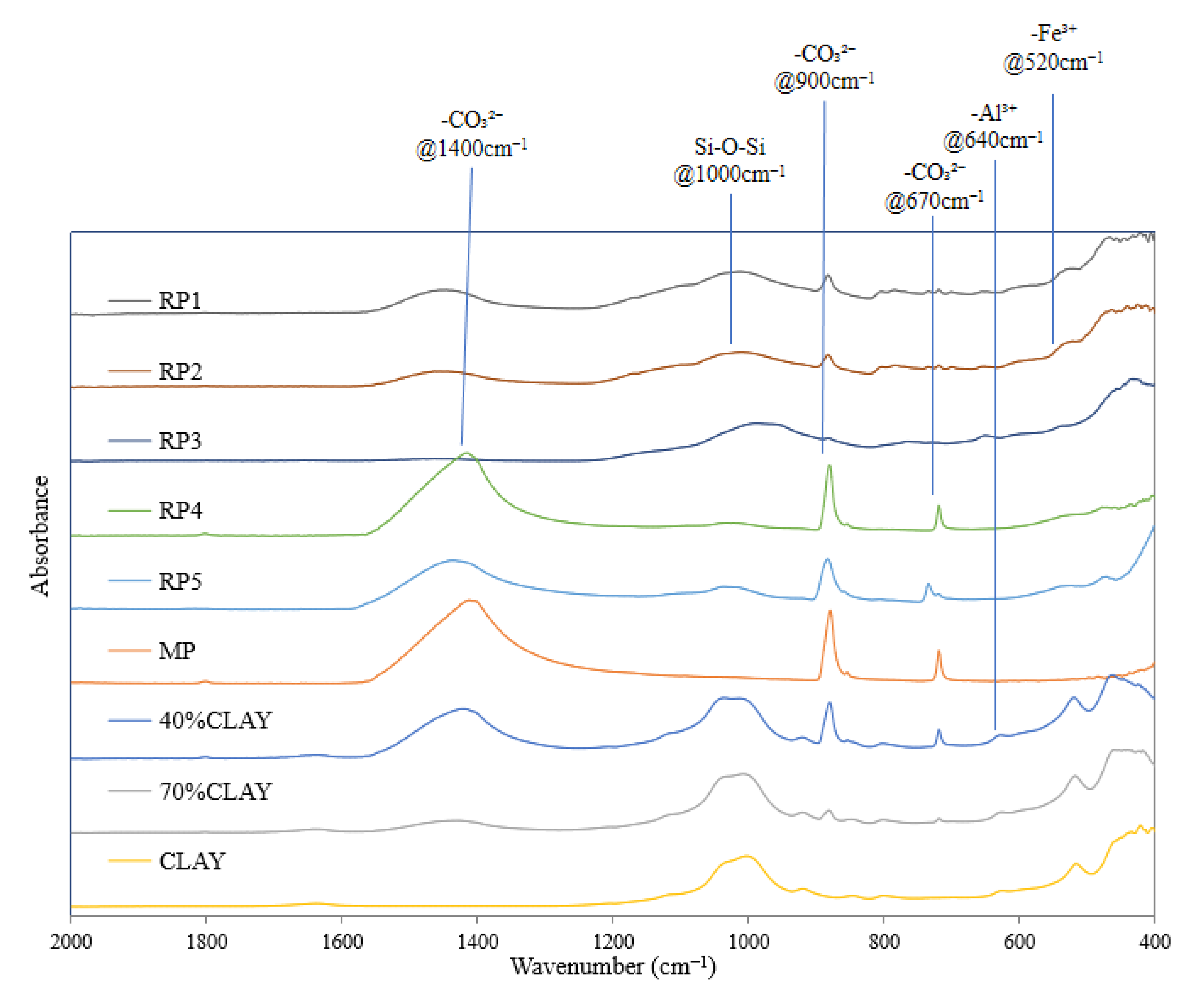

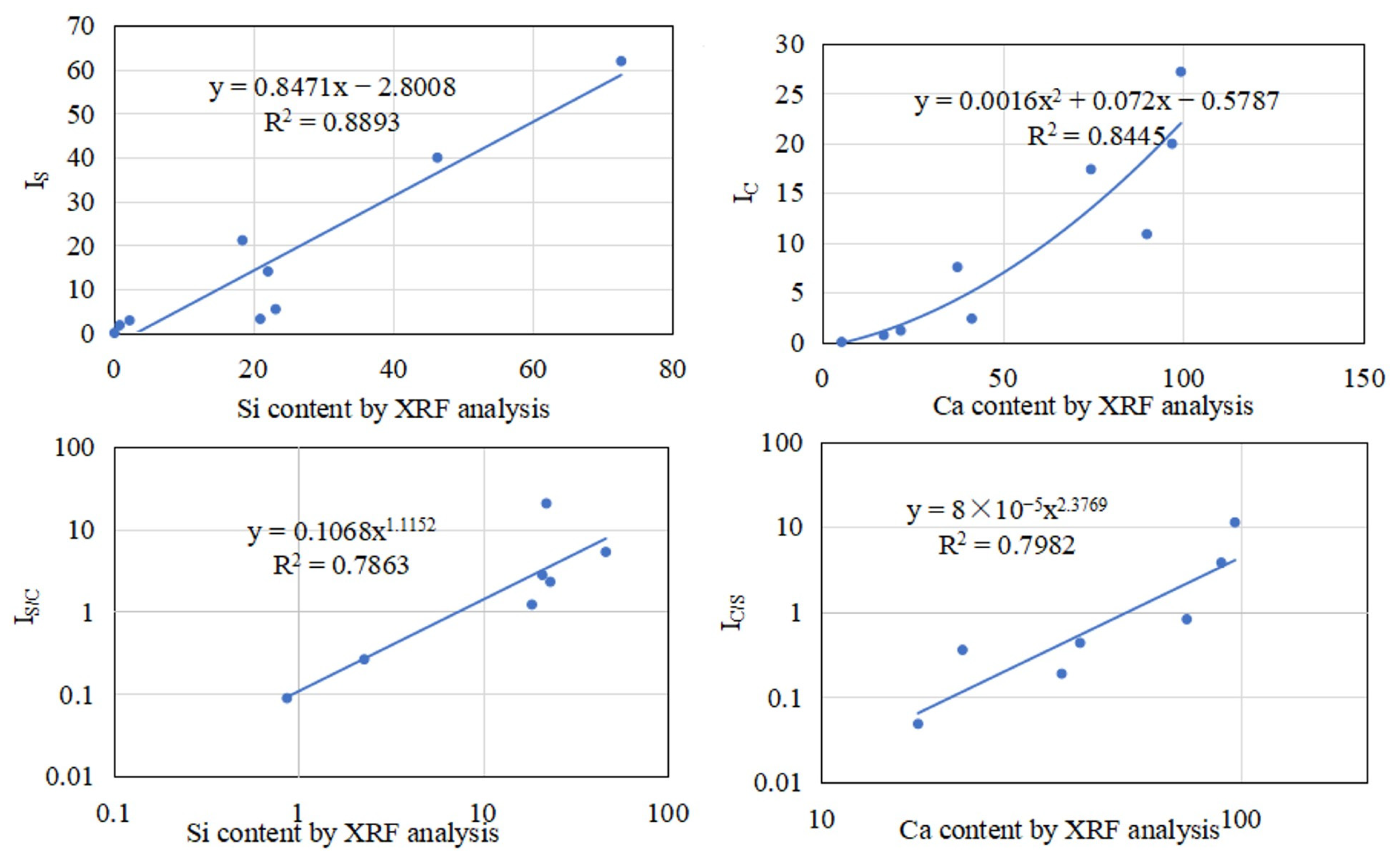
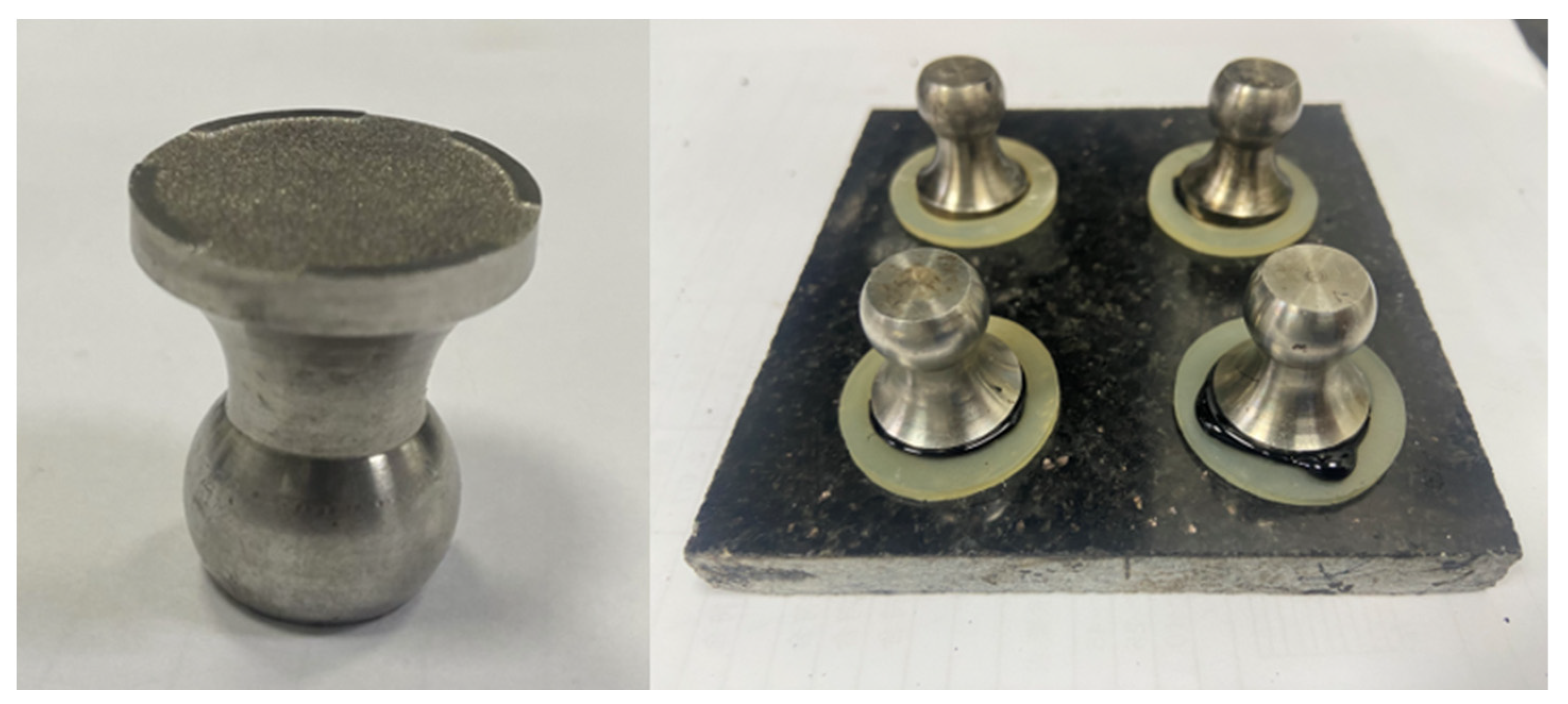
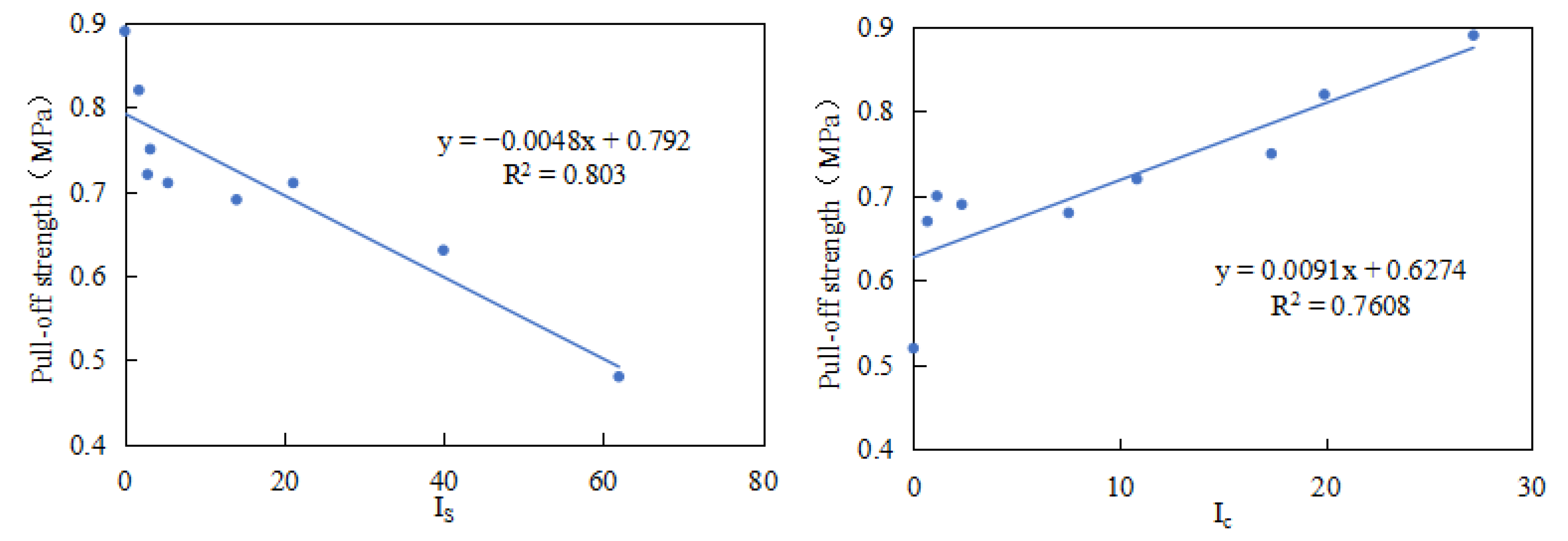

| Property | Test Method | RP1 | RP2 | RP3 | RP4 | RP5 | MP | 40% CLAY | 70% CLAY | CLAY |
|---|---|---|---|---|---|---|---|---|---|---|
| Density (g/cm3) | JTG 3432-2024 | 2.42 | 2.51 | 2.13 | 2.39 | 2.33 | 2.41 | 2.43 | 2.44 | 2.47 |
| Particle size (nm) | Laster particle test | 2946 | 3237 | 2891 | 2973 | 2976 | 3019 | 2985 | 3022 | 2926 |
| Color | \ | black | black | black | white | white | brown | brown | brown | brown |
| Source | municipal | municipal | municipal | highway | highway | lab-made | lab-made | lab-made | lab-made |
| Sample | SiO2 | CaCO3 | Al2O3 | Fe2O3 | MgO | TiO2 | K2O | Total |
|---|---|---|---|---|---|---|---|---|
| RP1 | 23 | 41 | 3 | 21 | 1 | 4 | 4 | 98 |
| RP2 | 21 | 22 | 6 | 39 | 1 | 7 | 2 | 98 |
| RP3 | 22 | 17 | 6 | 42 | 2 | 6 | 3 | 98 |
| RP4 | 1 | 97 | 0 | 1 | 0 | 0 | 0 | 99 |
| RP5 | 2 | 90 | 1 | 2 | 4 | 0 | 1 | 100 |
| MP | 0 | 99 | 0 | 0 | 0 | 0 | 0 | 100 |
| 40% CLAY | 18 | 74 | 3 | 2 | 1 | 0 | 0 | 100 |
| 70% CLAY | 46 | 37 | 9 | 5 | 1 | 0 | 1 | 99 |
| CLAY | 73 | 5 | 12 | 6 | 1 | 0 | 2 | 99 |
| Test Material | MBV |
|---|---|
| RP1 | 1.25 |
| RP2 | 10 |
| RP3 | 4 |
| RP4 | 1 |
| RP5 | 1.25 |
| MP | 0.5 |
| 40% CLAY | 138.5 |
| 70% CLAY | 241.25 |
| CLAY | 344.25 |
| IC | IS | IS/C | IC/S | |
|---|---|---|---|---|
| RP1 | 2.35 | 5.40 | 2.30 | 0.44 |
| RP2 | 1.14 | 3.18 | 2.79 | 0.36 |
| RP3 | 0.68 | 14.01 | 20.60 | 0.05 |
| RP4 | 19.93 | 1.77 | 0.09 | 11.26 |
| RP5 | 10.85 | 2.85 | 0.26 | 3.81 |
| MP | 27.17 | 0 | 0 | / |
| 40% CLAY | 17.4 | 21.1 | 1.21 | 0.82 |
| 70% CLAY | 7.5 | 39.9 | 5.32 | 0.19 |
| CLAY | 0.0 | 61.9 | / | 0.0 |
Disclaimer/Publisher’s Note: The statements, opinions and data contained in all publications are solely those of the individual author(s) and contributor(s) and not of MDPI and/or the editor(s). MDPI and/or the editor(s) disclaim responsibility for any injury to people or property resulting from any ideas, methods, instructions or products referred to in the content. |
© 2025 by the authors. Licensee MDPI, Basel, Switzerland. This article is an open access article distributed under the terms and conditions of the Creative Commons Attribution (CC BY) license (https://creativecommons.org/licenses/by/4.0/).
Share and Cite
Wu, H.; Yu, D.; Wang, W.; Yan, C.; Xiao, R.; Chen, R.; Zhang, P.; Zhang, H. A Study on the Characterization of Asphalt Plant Reclaimed Powder Using Fourier Transform Infrared Spectroscopy. Materials 2025, 18, 3660. https://doi.org/10.3390/ma18153660
Wu H, Yu D, Wang W, Yan C, Xiao R, Chen R, Zhang P, Zhang H. A Study on the Characterization of Asphalt Plant Reclaimed Powder Using Fourier Transform Infrared Spectroscopy. Materials. 2025; 18(15):3660. https://doi.org/10.3390/ma18153660
Chicago/Turabian StyleWu, Hao, Daoan Yu, Wentao Wang, Chuanqi Yan, Rui Xiao, Rong Chen, Peng Zhang, and Hengji Zhang. 2025. "A Study on the Characterization of Asphalt Plant Reclaimed Powder Using Fourier Transform Infrared Spectroscopy" Materials 18, no. 15: 3660. https://doi.org/10.3390/ma18153660
APA StyleWu, H., Yu, D., Wang, W., Yan, C., Xiao, R., Chen, R., Zhang, P., & Zhang, H. (2025). A Study on the Characterization of Asphalt Plant Reclaimed Powder Using Fourier Transform Infrared Spectroscopy. Materials, 18(15), 3660. https://doi.org/10.3390/ma18153660






